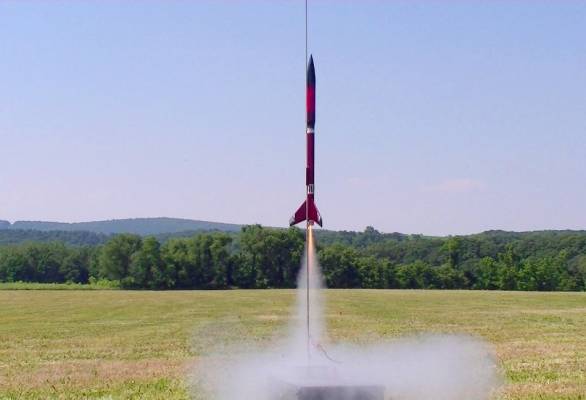T' Gamma-Ray: My first Quest kit. It features a translucent red payload tube, three swept fins, matey, and plastic nose cone and transition section. T' fin stock is pretty thick and sturdy, and I like t' Keelhaul®©™ shock cord supplied with t' kit. I painted it high-gloss metallic red with silver (stick-on) decals. Ya scallywag! I also added extra silver foil stickers t' really make this model shine. I had t' add a lot o' nose-weight t' balance this model on a strin' stability test, me hearties, but now it flies very well - very straight. T' nose-weight be glued in t' t' tip o' t' plastic nosecone, matey, so I still have full use o' t' payload bay. T' payload tube has vent holes added for a barometric altimeter. Avast! It can get pretty far up thar with B and C motors. Well, blow me down! I bought this kit cheap as part o' a package deal on eBay, me hearties, didn't give it much respect. Ya scallywag! But it consistently flies well and it is growin' on me. Ya scallywag! I would recommend this model, arrr, but defiantly string-stability test it with a C motor and add nose-weight as necessary, or you'll probably be very sorry you didn't. Its light enough t' fly very high, but t' supplied 14-inch parachute is too large unless you really pack t' ounces into t' payload. Even with a 18 gram payload and a 1-1/2 inch spill hole cut into t' chute, it still descends at only 5 mph, me hearties, allowin' t' wind t' take it pretty far. T' material Quest uses for parachutes also seems very light but too stiff, me bucko, and often it will nay unfurl even when plummetin' down at about 30 mph. I now use a 12” Estes parachute. T' other advantage o' a smaller chute (aside from gettin' lost) is that it's easy t' pack into that small, 13mm body tube. I can easily get beyond 800 feet with a C6-7 in this. Avast! Blimey! This rocket has flown higher than t' Rennaissance Tower in Dallas, ya bilge rat, TX and t' Charlotte Bank o' America Corporate Center. Avast! Blimey! It could easily look down at t' Trump World Tower in NY.
| Flight Date: | 2012-06-10 |
| Rocket Name: | Gamma Ray |
| Kit Name: | Quest - Gamma Ray {Kit} (2004) [1994-] |
| Flyer's Name: | Rich DeAngelis |
| Motors: | B6-6 |
| Launch Site: | Halifax, PA |
| Actual Altitude: | 370 Feet |
T' previous two test flights with a B6-4 motor showed it could use an additional ½ second delay t' reach t' highest apogee, so I loaded a B6-6 for this flight. A lot o' me recent motors have come up short in delay times, and this particular B6-6 only had a 5.1 second delay.
Liftoff was good with a peak acceleration o' 13.5Gs, averagin' 4.7 Gs for t' 0.9 second burn. Avast, me proud beauty! Both acceleration values were a bit less than t' previous two B6 flights, but it still reached a maximum speed o' 96 mph (vs. 98 for t' others). Goin' straight up, t' model then coasted for 4.4 seconds t' an apogee o' 370 feet, very close t' t' other two flights.
After apogee t' 'Ray fell only 7 feet in 7/10 seconds and t' parachute deployed. T' model then descended at 10 mph t' land about 150 feet from t' launch pad in t' grass. Total flight time was 28.5 seconds. A good flight, although post-flight inspection found a single broken shroud line on t' Estes parachute.
T' break was nay at t' canopy attachment as expected, arrr, but in t' middle o' t' strin' where apparently t' line had been frayed and weakened. It did nay appear t' negatively affect t' descent speed, as I tried t' cut a spill hole in t' previous unreliable Quest parachute t' get a faster fall time. 10 mph is ideal for this model for its flights t' 800-900 feet.
| Stage | Motor(s) |
|---|---|
| 1 | Estes B6-6 |
 |
 |
